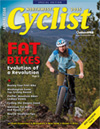On the Run: Running Your First Ultra-Marathon

By Clint Cherepa
Photo at right: Former OutdoorsNW editor Yitka Winn is all smiles during the Angels Staircase ultra in Washington state’s Okanogan National Forest. Photo by Glenn Tachiyama, www.tachifoto.net
Tip: Start at the back of the pack and go slow
When a 5k sucks every last bit of juice out of you, how could you ever run a marathon, not to mention a 50k or 100k (or more) ultra-marathon?
The beautiful thing about running is that it is all about gradually adding on miles.
It is the rare runner who has not heard about ultra-marathoning. It brings a tingle of anticipation to imagine running and completing an ultra-marathon. The good news: you can do it. With a love of running and determination, an ultra is within your reach.
Choose an “Easy” Ultra
Kent Keeler of RunBikeRace.com ran his first ultra last September. His approach was to start with a 50k and work up. He also suggests that newbies consider whether the race is a point-to-point, loop or multi-lap course.
“These all have potential psychological positive and negative effects,” says Keeler. “I have only done multiple lap courses, and I like them because I have a good sense of where I am on the course, and what is left before the finish.”
Yitka Winn—who has run over a dozen ultras in Washington, Oregon, Idaho, Colorado and even the Canary Islands in Spain—suggests that “while it may take you longer to run a hilly or mountainous course, the climbs and descents actually give your body a break throughout the race, because you get to hike (lower impact) and use different muscles than repetitively running on a flat surface.”
Canadian ultra-runner and international expedition leader Ray Zahab says that a person should choose a race they feel committed to, but also pick one that has reasonable mileage.
Forget Fast, Go Slow
Speed is not key in the world of ultra-running. Blasting off at the start of a 5k or 10k might mean a harder race, but with ultra-running it means a DNF (Did Not Finish). Walking breaks are the strategy of many ultra-runners, especially on the inclines.
As a first-time ultra-runner it is advised that you start at the back of the pack and go slow.
“Incorporate walking on steep climbs, or even just at regular intervals,” emphasizes Winn. “In an ultra, even the front-of-the-pack elite runners rarely ‘run’ every step of the way.”
Remember, the last half or quarter of your ultra will be hard, and even harder if you start out too quick.
Back-to-Back Long Runs
One thing that sets ultra-marathon training apart from training for shorter races is the back-to-back long runs. Many ultra-runners simulate the tiredness that their bodies will encounter during the ultra by running long distances, two days in a row. The idea is to train the body and mind to continue even after it feels there is nothing left.
Zahab says that back-to-back runs are a great training tool, but cautions, “don’t confuse quantity and quality. Training programs should include a combination of speed work, pow er and hill workouts, tempo running and functional strength and conditioning.”
If you can’t find the time to run back-to-back long runs follow Winn’s training plan and focus on a few key long training runs of 30–45 mi les at a pop.
Eat and Run
Calories are vital in finishing an ultra. This is why most ultra-marathons have well-stocked aid stations along the race course. From M&Ms to salted potatoes and chicken soup, aid stations are oases.
Sports nutritionist Sunny Blende suggests in her article, Ultra Endurance Fueling, that, “to delay fatigue and keep performing at your best during an ultra, you need to replace carbohydrates before your glycogen stores get depleted.”
Blende also notes that during extensive exercise you can burn an average max of “about 240 calories per hour or about one gram per minute of exercise.”
As a rule of thumb, try to take in 300 calories an hour.
Train on the Terrain
Ultras come in all shapes and sizes. There are mountainous courses with never-ending ascents and descents, courses as flat as flapjacks and ones with mud, sand, roots, rocks and river crossings.
When Winn signed up for her first 50-miler, the White River 50 near Crystal Mountain, she saw that the elevation profile had a roughly 10-mile stretch of uphill.
“Because Seattle, as far as I know, is lacking in 10-mile hills, I heeded a friend’s advice and ‘hiked’ once a week, for two hours at a time, on a treadmill set at 15-percent incline,” says Winn. “That helped prepare my legs to carry me uphill for hours on end, which translated very well to the trails come race day.”
Keeler took advantage of the training-day set up by the race directors a few months before race day.
“Experiencing the course helped me to find local spots with similar terrain to train on,” Keeler says.
Every marathon runner started at the bottom and built up time on their feet until they could run the marathon distance. So, if you have run a marathon, you can run an ultra-marathon, maintains Keeler.
He adds that you need to keep that marathon state-of-mind: one foot in front of the other, week after week to reach your destination.
Stay Motivated
“Be happy you’re here.” This was Keeler’s mantra during tough times.
“I remind myself that I have a lot of other commitments, and I have been granted the time, and the good health to be able to get out and run for a few hours.”
Positive peer pressure and the infectious vibe from like-minded runners will keep you on track with your training. The love of the ultra is contagious.
“I love to be out in the mountains for hours at a time, and quickly fell in love with the trail- and ultra-running community in Seattle, where I lived at the time,” says Winn who now runs the steeps in Colorado where she is Associate Editor of Trail Runner magazine. “This sport is full of vibrant, fun-loving people, which is what’s kept me hooked more than anything.”
In the big picture, ultra-marathoning is for mortals. Take a few steps and then take a few more and you will be on your way to a success with your first ultra
Clint Cherepa is the Running Columnist for OutdoorsNW. He is currently in Nicaragua, where he has been busy training for ultra-marathons and working on a new venture: www.strongerrunners.com
Miss a column? Log onto www.OutdoorsNW.com – search On the Run.
Editor’s Note: To read Sunny Blende’s full article, Ultra Endurance Fueling, go to: www.eat4fitness.com/articles/ultra.pdf
15 Ultra-Marathons for Newbies
Thinking about training for your first ultra? Here are 15 races in Washington and Oregon that have been recommended by seasoned Northwest ultra-runners.
Washingtoni
February
Lord Hill 50k: www.evergreentrailruns.com
Orcas Island 50k: www.rainshadowrunning.com
March
Chuckanut Mountain 50k: www.chuckanut50krace.com
Gorge Waterfall 50k: www.rainshadowrunning.com
Mt. Si 50k: www.mtsirelay.com
May
Sun Mountain 50k: www.rainshadowrunning.com
Soaring Eagle 50k: www.evergreentrailruns.com
June
Lake Youngs Ultra: www.lakeyoungsultra.com
Echo Valley 50k: www.evergreentrailruns.com
July
White River 50k: www.whiteriver50.com
October
Cougar Mountain 50k: www.nwtrailruns.com
Baker Lake 50k: www.bakerlake50k.com
December
Deception Pass 50k: www.rainshadowrunning.com
Oregon
February
ORRC Hagg Lake 50k: www.haggmud.com
May
McDonald Forest 50k: www.mac50k.org
Editor’s Note: Thanks to Ben Luedke (www.SeattleMountainRunningGroup.com; www.RunningTheCascades.com), Phil Kochik (www.sevenhillsrunningshop.com) and Glenn Tachiyama (www.tachifoto.net) who helped compile this list.




